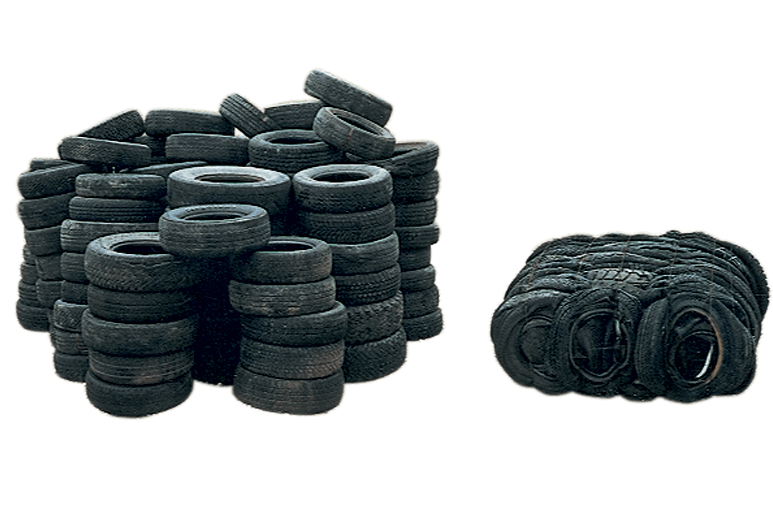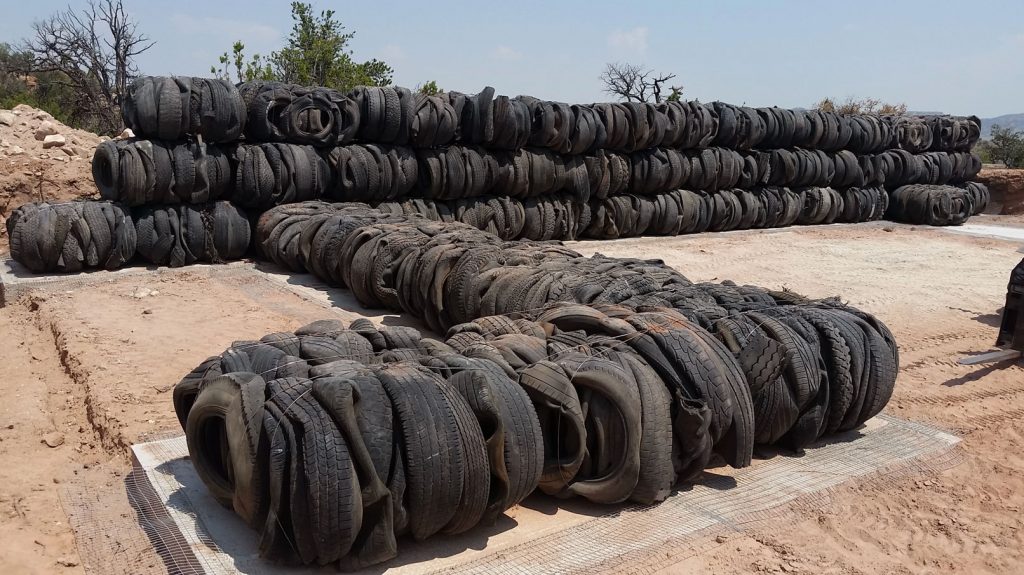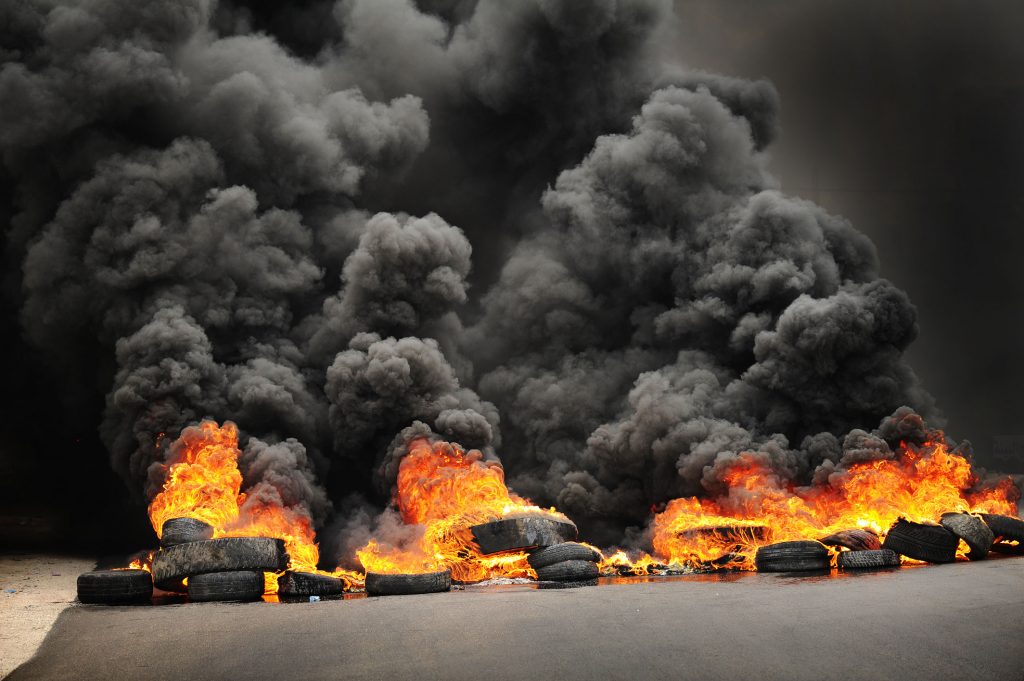How can baled tires be an excellent recycling solution? The world is searching for long-lasting, cost-effective materials and ways to lessen our environmental impacts. But tires continue to pose monumental challenges in today’s environmentally conscious efforts to leave the Earth in a better place for the next generation.
We think it’s time to consider baled tires – or maybe reconsider. While tire baling has been around for decades, tire shredders’ increased capacity has decreased the need for baling tires. These shredders are large and impressive pieces of equipment with lots of moving parts. They must remain where they are installed, and end-of-life tire stock must be brought in to feed the machines. This brings up the first way that baling can still make a viable impact.

Baled Tires Are Easier To Transport
According to the Environmental Protection Agency (EPA) there are 290 million scrap tires generated in the United States alone. Fortunately, 80% of these tires have found a place in the market for reuse or recycling. To increase the marketability of end-of-life tires, they need to be transportable. Transporting tires, historically, has meant manually stacking them into trailers or containers as-is. This leaves large amounts of empty air space and inefficient loads for transport. Baling tires remove the majority of this wasted space.
Bulk baled tires can be loaded and transported quicker and more efficiently. Whole tires can be loaded into machines like the Eagle 3260 Baler or the Eagle 4566 Baler. Each bale can consist of around 100 compressed tires of various sizes. These packed tires reduce the overall cost when transporting tires from storage or dumps to recycling processors or excavation projects. The resulting bales are easily loaded into a trailer or shipping container with minimal air space left over.

Baled Tires are Better Building Blocks
Combatting erosion, improving facilities, and building roadways are just a few projects that can utilize scrap tire bales. Eagle 4566 Baler compress tires into bales measuring 45″ x 54″ x 66″ (114 cm x 137 cm x 167 cm), which are comparable to concrete “enviro-blocks” used in retaining walls and erosion control projects. These bales are roughly half the weight of conventional materials and are ideal for wet locations due to their high permeability allowing for proper drainage.
With the recent popularity of off-grid and low-cost homes, tire-bales are a no-brainer for building materials. The large blocks can be stacked to create thick walls that can be sprayed with concrete or (more traditionally and environmentally friendly) cobbing by hand. These heavily insulated walls can play a huge role in sound dampening and heating/cooling a structure.

This image shows the foundation for a tire bale home under construction in New Mexico. You can read more about their process, how they planned their build, and where they sourced their materials at their blog: https://www.brownkawa.com/
Here is another home featured on NaturalBuildingBlog.com that shows a home finished in 2020 by a Colorado couple.
Homes aren’t the only structures that people can make with tire bales. There have been hundreds of civil engineering projects that incorporate baled tires as forms for dams, embankments, levees, retaining walls, windbreaks, and landfills.
Mitigate Fire Risk
One of the most considerable risks of tires stored for disposal is the potential for fire. Although infrequent, tire fires are serious due to their toxicity and the level of difficulty to extinguish the blaze. It has been well documented that stockpiled tires that catch can burn for several years. In some cases, the only way to control the spread of tire fires has been to bury it and leave it to burn out underground – resulting in even more complicated environmental concerns.
These fires release a thick, black smoke and an oily residue that contaminates soil and ground and surface water with toxins like benzene, styrene, butadiene, polycyclic aromatic hydrocarbons (PAHs), arsenic, and lead.

Take, for instance, the 7-million tire fire in Rhinehart, Virginia, in 1983. According to the EPA, a plume of smoke 3,000 feet high and 50 miles long dropped pollutants across three states. This fire burned for nine months.
In January 2000, a test was completed by Central Recycling Services in Niagara Falls, Ontario. It included three separate scenarios and two different types of tire fires: a baled tire set ablaze by a grass fire, a pile of tires lit by a grass fire, and a tire bale ignited by arson. The burns were overseen by members of the Willoughby Volunteer Fire Hall.
Scenario One
A tire bale was set on top of and surrounded by straw. The straw was doused with one liter of gasoline and ignited. After burning for five minutes, the outside of the bale had caught fire. Within 1 minute and 45 seconds, testers quickly extinguished the blaze with water.
Scenario Two
Loose tires were piled on a bed of straw and lit in the same manner as the previous burn. According to the test report:
the tires caught fire very quickly and started to burn at very high temperatures…this fire burned for only three minutes before the Fire Chief decided it would be a good time to extinguish it before it got out of hand…the burn lasted for three minutes and took the fireman seven and a half minutes to extinguish the flames [with a foam mixture]. The pile then had to be separated with a pole hook and doused inside to make sure it was completely out.
Scenario Three
A bale was set on fire in a mock-arson attempt. Approximately three liters of gasoline were poured on top of the bale and allowed to penetrate the bale’s center. After two minutes, the bale was ignited, and the fuel quickly burned. But the bale had only burned where the accelerant had spilled. As the fire traveled inside the bale, several small explosions were heard throughout the seven-minute burn time. According to the report, “the bale did NOT seem to get engulfed in flames or become fully involved, only to a point where there was a small flame and a bit of smoldering smoke.” Firemen commenced to douse the fire with water at the eight-minute mark, and was fully extinguished in less than two minutes.
To view a copy of the official report, the download link below:.
Reduce Health Hazards With Baled Tires
While tires sit at the dumpsite, they will collect water as tires do. This stagnant, bacteria-ridden water becomes a breeding ground for insects, such as mosquitos, which can carry various diseases, such as malaria, dengue, West Nile, and Zika, depending on your location in the world.

The water in these tires can also carry parasites, which can be transmitted to animals when they drink it.
When tires are baled, they are compressed so that the majority of open space in each tire is significantly reduced. This decreases the space available for water to collect.
As you can see, there are many benefits to baling tires, and all of them have positive impacts on the environment. Companies continue to innovate better ways to recycle tires with the ultimate goal of a circular economy. While these innovations take hold, we think the tire baler is a great way to increase margins by lowing transportation and storage costs while mitigating environmental risks.
